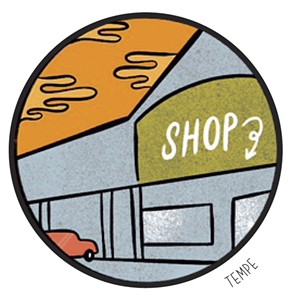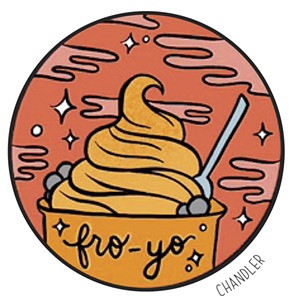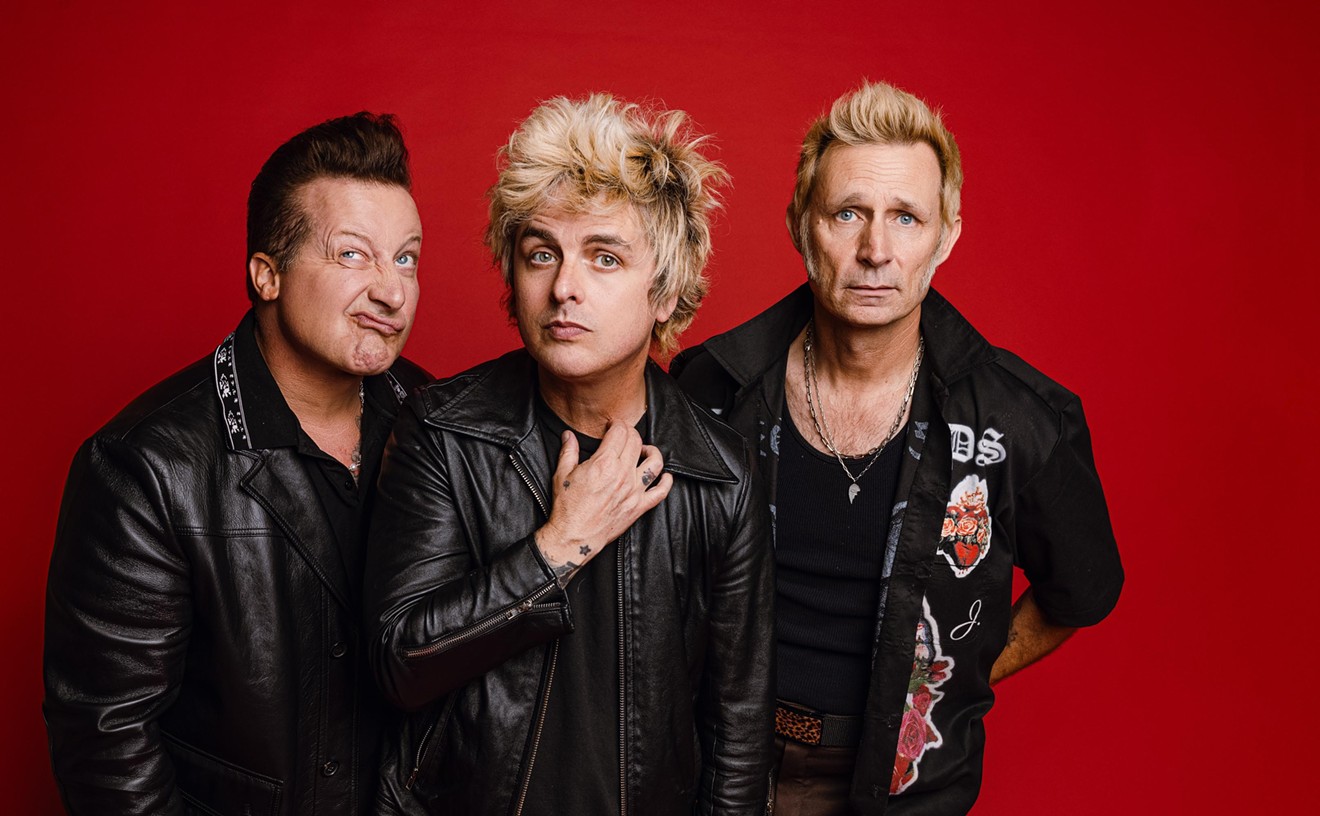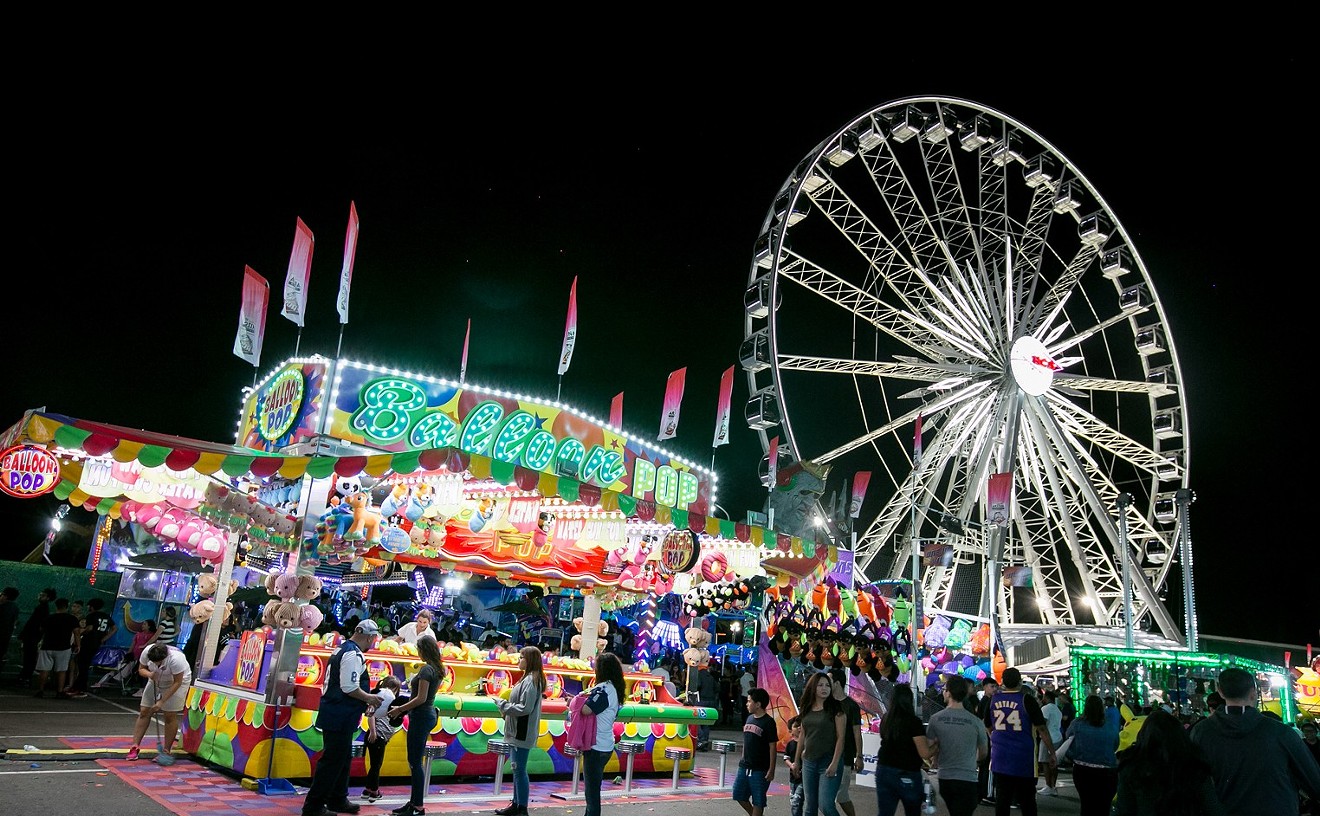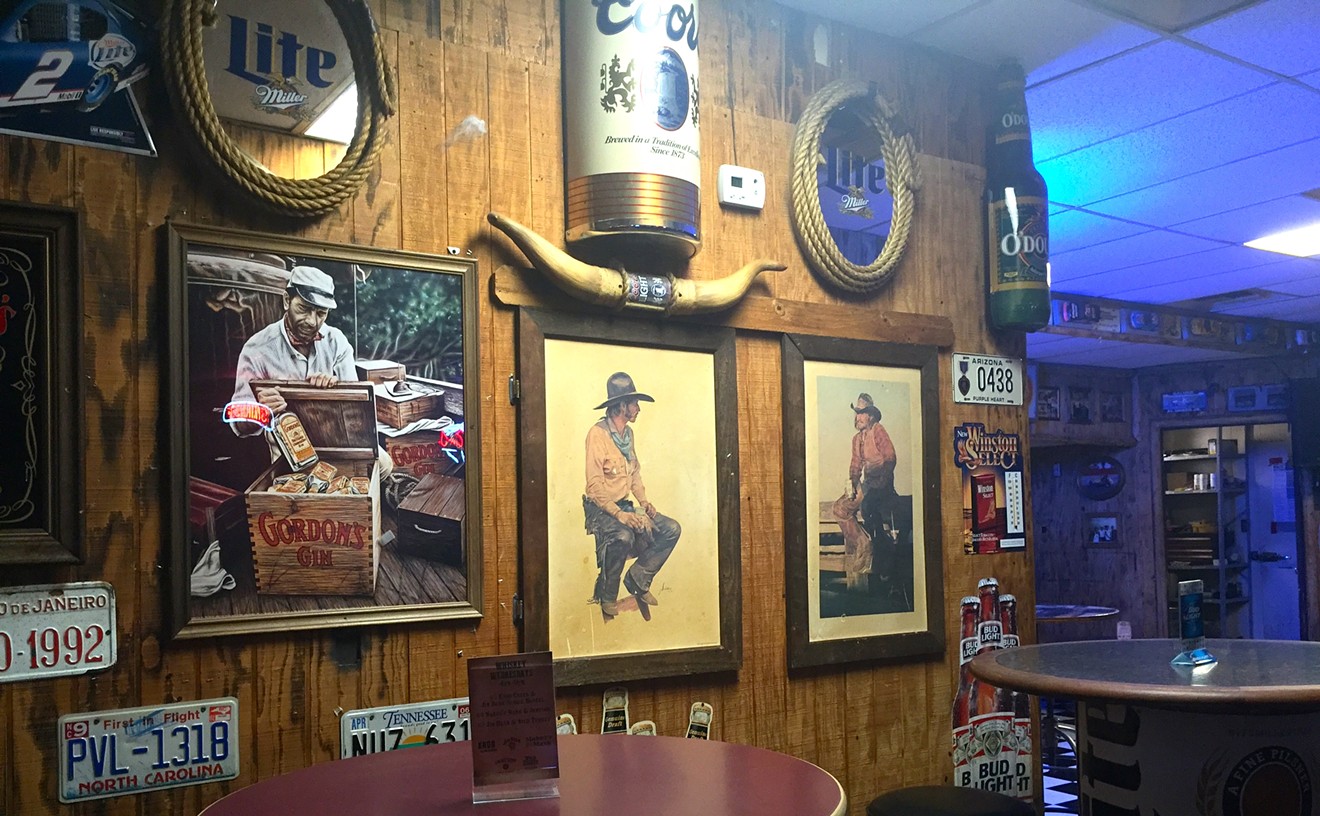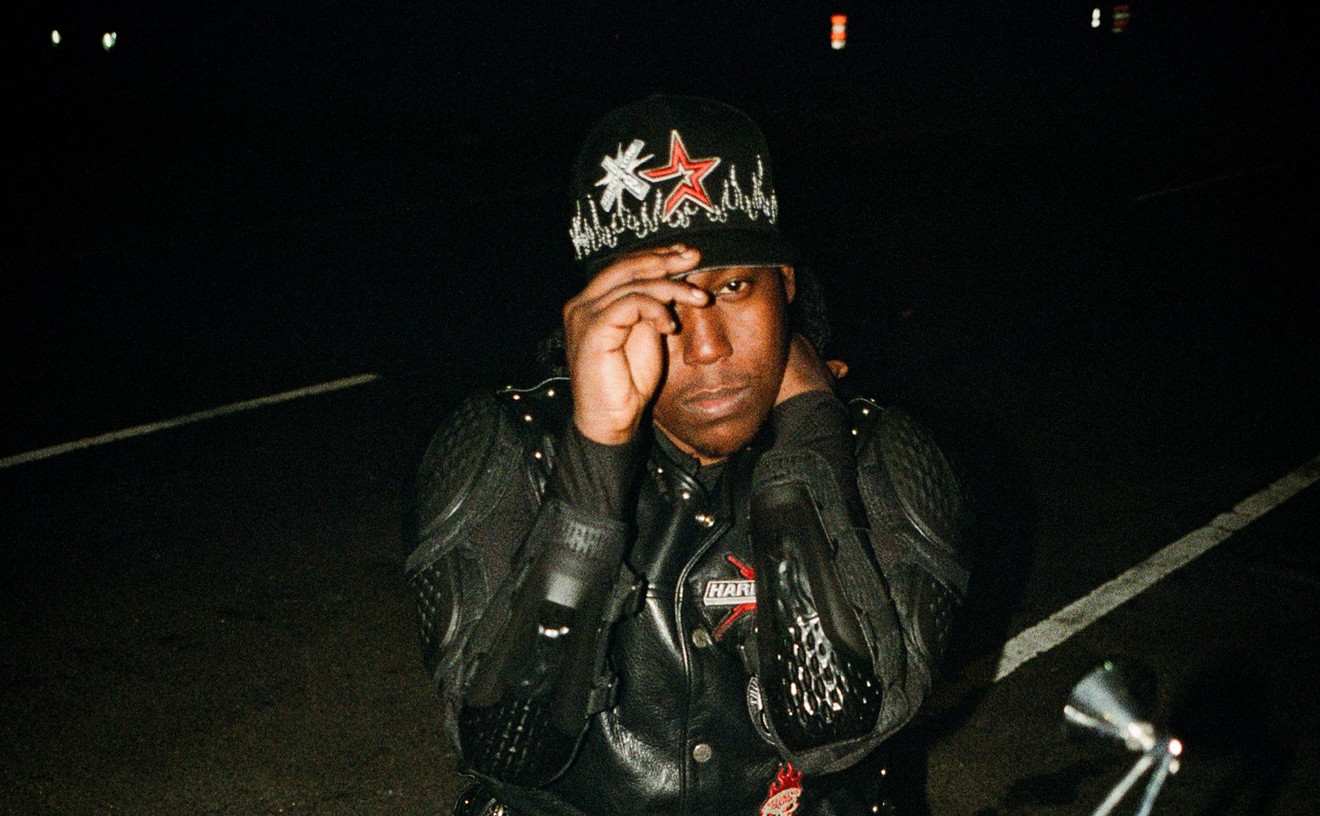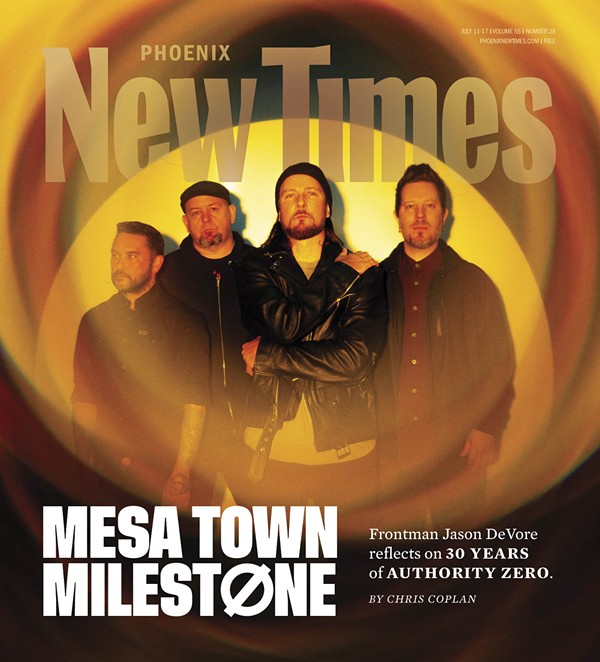There’s that kooky notion that smell is the closest sense tied to memory. But nothing draws you back into the distant past quite so ferociously as a beloved song. It takes only a few notes of some forgotten pop gem or classic rock jam to send the brain reeling over childhood friendships, first romances, or beating Super Mario Bros. 2. That dynamic is especially true for places, like a beloved bookstore, a picturesque mountain getaway, or some dingy place from your awkward teen years.
In the spirit of this dynamic, and given that summer is the perfect time for driving — as both pleasure and escape, in the case of Arizonans — we’ve assembled our own musical road trip. This series is a chance for staff writers and Valley stakeholders to share those special songs irrevocably tied to places, significant or otherwise.
To cope with growing up in Chandler, Phoenix New Times contributor Gerrit Feenstra leans on Kings of Leon’s “Arizona.” Stinkweeds owner Kimber Lanning shares the innate connection between her early days in Tempe and U.K. rockers Saint Etienne. Plus, we have essays on how the Eagles saved Winslow, The Minutemen’s influence on Tucson/Phoenix culture, and the definitive guide to the best Grand Canyon songs.
It’s our hope that we can celebrate this special connection between music and geography. Or, maybe just offer up a soundtrack for your own summer wanderings. Either way, we want you to share your own music-powered memories and adventures from all across Arizona. May the rest of your summer be eternal, your A/C extra chilly, and the tunes plentiful.
'Fractured Skies'
On music, road trips, and coming home to PhoenixLiving in Chicago made me feel small — likely just another design feature of the Second City. Like how Willis Tower dominates an already crowded skyline; the $1 million condos poured into minuscule lots; and the sprawl of Lake Michigan extending the city limits beyond the horizon.
But I was already feeling teeny-tiny before I’d crossed into Illinois in late October 2014, reeling at the sudden end of my marriage. By that February, I’d shrink further still after the one-two punch of a deceased dog (R.I.P. Lord Rupert) and sudden unemployment.
During long train rides on the Red Line, or wandering for hours in the Loop, I’d listen to “Fractured Skies” by the Brooklyn noise rock band Parts & Labor. It’s the perfect song for sustained movement, its mad-dash of drums and screeching guitars building into this massive overture of blissful noise supercharging the human body.
Yet “Fractured Skies” never made me feel better, even if the song’s momentum could prove motivational. Instead, it was just one more thing reminding me of my physical and emotional size, and I could get lost within that sensibility. Listening to this sonic explosion left me feeling safe, deeply comforted in the knowledge that the world was so huge, my problems were utterly insignificant compared to the universe’s churning.
Even that shred of comfort wasn’t enough, and in September 2017, I retreated home to Phoenix. The city’s 517 square miles may dwarf Chicago’s 234 square miles, but Phoenix conversely feels much smaller. It’s likely the endless freeways that condense the Valley, making everything feel accessible in this massive desert.
“Fractured Skies” became a frequent part of my driving playlists. I’d get my red Mazda3 up to 70 miles per hour as I bulleted from Interstate 17 South to the Interstate 10 East on-ramp. Or, blare the tune on long trips to and from south Chandler for family dinners. Those same swells and frenetic energy never brought up my own baggage or stirred that same old comfortable feeling. Instead, I wanted to keep pace with this song — speed limits be damned.
Moving back to Phoenix, a city I know intimately, and that is filled with warm familiarity, gave me back some semblance of a life. I let myself mourn my losses and moved on with a new love, more writing projects, and time spent actually enjoying the world. Driving was a huge part of that, and it reminded me how small everything could become.
“Fractured Skies” became an anthem for just that — a spark reminding me of who I was and how I wanted to live. The song serves as the soundtrack to adventures and dreams I felt I could finally chase. No longer was the song some safety blanket, but it was also a surge pushing me into the world, embracing every glory or misstep that came on the open road.
Ultimately, it was my own commitment and hard work that brought me back from the emotional brink. Yet “Fractured Skies” showed me what comes next. Chris Coplan.
'Dog Problems'
At Modified Arts, Grace Perry found her destiny downtownGrace Perry’s life has been devoted to helping grow Phoenix. In her day job, she serves as director of development for Arizona Theatre Company. At night, she runs Gracie’s Tax Bar, where all sorts of local stakeholders — including many New Times staff — regularly congregate. Meanwhile, from 2004 to 2012, she was part of the niche Valley death-metal scene as frontwoman of Landmine Marathon.
But for Perry, a third-generation Arizona resident, the journey all started back in high school, when she’d frequent shows at Modified Arts.
“This was before everything was gentrified,” she says, laughing. “I had moved to Phoenix from Tucson midway in high school and was introduced to the area. It all sort of blossomed from there.”
Perry’s foray into downtown was in the mid-2000s, where a host of young and hungry bands played at Modified, a cramped space more resembling a creepy church basement than a rock club. Chief among those bands were The Format, a clear favorite of Perry’s. As a teen, she recalls gleefully singing along to tunes like the latter-day single “Dog Problems,” which spoke volumes to her adolescent hopes and hangups.
“They talk about ‘swooping haircuts are bringing me down,’” she says. “But also things about hating the world and trying to still get through it. It’s very angsty, but then also very funny. It was so much fun to scream at the top of your lungs.”
Perry admits that both the song and Modified came into her life when you “just started feeling like you are more in tune with who you are and who you want to be.” As such, the two entities became elements of her young identity, a representation of the belonging many teenagers crave.
“It’s certainly harder to be into music than other cities,” Perry says of the Valley. “It was so important having this hub, this network in place. There wasn’t a lot of places you could meet like-minded people.”
Perry contributes a lot of Modified’s success to its original owner, Kimber Lanning, who Perry says is “someone all female entrepreneurs in the city are awed by.” Eventually, Perry got to meet Lanning when her very first band, the shock-rock group Osama bin SARS, played Modified some years later.
“To watch a show, and then play there, there’s nothing quite as fulfilling,” she says. Perry adds it was touching to re-experience a venue “run by volunteers, run by pure love.”
These days, Perry is happy to work behind the scenes. She says she’ll still spin “Dog Problems” from time to time, whereupon she’s reminded of the connection between herself and the city she loves.
“It’s been so great to see how (Phoenix) has evolved,” she says. “I’m proud to have grown up here and help to contribute in building and preserving Phoenix culture. There has been a clear and positive growth in venues downtown, but I feel like the genesis of it all (was Modified) — it’s all tied together for me and my journey.” CC
Foxbase Alpha
Kimber Lanning built her arts legacy from a Tempe shopping centerKimber Lanning is a true local legend. As the owner of Stinkweeds and founder of Modified Arts, she pioneered the Valley’s arts and music scene. More recently, as the founder of Local First Arizona, she’s used that same progressive spirit in growing Arizona’s economy. But she’s not always been such an esteemed and recognizable member of the community.
“Once when I had moved (Stinkweeds), I was exhausted, so I laid down on the concrete floor and fell asleep with Saint Etienne’s Foxbase Alpha on repeat,” she says. “I was awoken by the police banging on the door at around 4 a.m. One of my longtime customers — who knows why he was pressing his face against the glass at 4 a.m. — saw my feet and called the cops. Nice to know I’m loved.”
Luckily, it wasn’t that intrusive customer that stuck with Lanning but the Saint Etienne record. Lanning says the album has been with her through multiple Stinkweeds relocations, most notably during the store’s stint at Apache Boulevard and Dorsey Lane in Tempe circa 1995 to 2006. The album’s a consistent reminder of how much Lanning puts into these shops.
“I still think of the bittersweet feeling of moving a store whenever I hear that album,” she says. “The excitement of the new place, but the sadness of another chapter gone. I think it was etched into my brain in the wee hours.”
Lanning speaks of the Apache location as an integral part of her legacy in the Valley, calling it a “springboard” for her efforts with Modified Arts. At one time, the store ran three to five shows per week, holding concerts for iconic indie acts like Neutral Milk Hotel and Red House Painters, among others.
“At the time, we didn’t have a promoter on top of indie rock,” Lanning says. “Charlie (Levy, of Stateside Presents fame) wasn’t managing that kinda stuff, and the whole Tempe music scene was not a part of it.”
Lanning’s work with Stinkweeds, Modified, and Local First has shifted in the intervening years. However, the album remains a presence in her life, even if she’s only listened to it “maybe five times in the last 10 years or so.” Mere ownership is good enough, given her fickle collecting habits.
“I still own it on CD,” she says. “The ratio of music I can’t stand is 10 percent, plus another 80 percent I couldn’t care less. That final 10 percent I love makes it to my home.”
Even if it’s not part of any regular playlists, Lanning says the LP holds value, a genuine artifact encapsulating her devotion to music and arts. Plus, it’s still a killer bedtime soundtrack.
“[The Apache store] was the introduction for so many bands in Phoenix,” she says.
“I think about [the album] every time I’ve gone through different things. Every time I enter a new chapter, I like to pause and pay respect, to be mindful of the passage of time.” CC
'Arizona’
Long summer nights with Chandler in the rear view mirrorEveryone loves songs that remind them of home, even when they make home look bad.
I bought Kings of Leon’s Because of the Times the summer before I went off to college. To pass the days, I’d picked up a night shift at a local by-the-ounce frozen yogurt place. I’d clean out the soft-serve machines at the end of each night, disassembling them and soaking every part in the state-mandated soapy cleaning bath.
The job didn’t start until after closing, which on weekends, wasn’t until 11 p.m. The night shift was all teens, many of them polite Mormon sophomores and juniors, excited to host their friends a full five minutes after official closing, but never jeopardizing their gas money. I would exchange pleasantries before they each yawned and said it was time for bed.
Each night, the process took about four hours. The slow emptying and refilling of the machines, waiting for things to unfreeze, and then freeze again. Back between dueling deep freezers, I’d spend 30 minutes chipping away at frozen sorbet. After four years of honors classes and AP tests, the trite proverb of “hurry up and wait” had never felt more aggravating.
Because of the Times is a record about going away. It starts on the edge of a shotgun wedding, and it ends in a brothel in Arizona. Most of the subject matter was the stuff of fairy tales to me, but I knew one thing: going away. I knew that soon, I’d be someplace else, apart from the monotony of the frozen yogurt shop, not waiting for anyone or anything.
When I was done with my shift at 3 a.m., I’d get on the 202 freeway and drive the whole loop around the Valley. That time of night, there was no traffic, so I could set my cruise control and just enjoy the rumbling of the asphalt beneath my tires. Because of the Times was my soundtrack of choice. Here, on the cusp of young manhood, I welcomed the prospect of change like I welcomed the darkened highway. Going away was lonely, but also full of possibility.
I timed my drive so that I’d pull into my neighborhood as “Arizona” began. Driving slowly past the darkened windows, I’d wonder what “whorehouse Arizona” meant to me. You can interpret the song literally, if you want — a pair of brothers finding themselves loaded and looking for action in all the wrong places. But I could only think of the feeling, venturing out with low expectations, finding yourself pleasantly surprised to be sent home without what you came for.
I hoped my journey wouldn’t end the same way, drunk only to be sobered by shame and embarrassment. I hoped I’d have the bravery to expect more, looking to a different horizon, as night slowly gave way to day again, toward the broken vestige of a lightbulb crawling into view. Gerrit Feenstra
‘History Lesson Part II’
The ghost of D. Boon haunts the I-10Driving down Interstate 10, it’s hard to imagine that such a boring road could be a death trap. The road that connects Phoenix to Tucson and Tucson to the California border is full of gentle curves and long stretches of nothing with only a few flashes of weirdness to break up the monotony: the gross pro-life billboards that glare at you as you get close to Eloy, Rooster Cogburn’s ostrich ranch, the small golf-cart repair shop out in the middle of nowhere near Tucson. And every now and then, there are small flowery crosses dotting the sides of the road — little reminders that the desert is always hungry and the I-10 is more than capable of feeding it.
Earlier this year, the Liverpool-based band Her got into a fiery car crash on the 10. They were leaving Tucson on March 27, heading toward California when tragedy struck. The crash killed Her’s Stephen Fitzpatrick and Audun Laading, as well as their tour manager Trevor Engelbrektson. Reading about the accident, I couldn’t help but feel deja vu trace a cold finger up my spine — this wasn’t the first time a promising musical group met its end on the Interstate 10.
The Minutemen’s D. Boon also met his end on the highway. Driving out of Tucson on December 22, 1985, in a van with his fiancée and her sister, Boon’s vehicle swerved off the road while heading towards the California border. Boon, feverish and exhausted, was sleeping in the back of the van when the accident happened. The force of the impact threw the singer and guitarist out the back of the van, breaking his neck instantly. Boon was 27 years old.
Say the word “Minutemen” to most Phoenicians and the first image that will probably come to mind is a bunch of angry white yahoos playing militia in the desert. But to those active in the Phoenix underground, the real Minutemen are a cultural touchstone. It’s not just in the obvious ways — like how the band’s classic 1984 record Double Nickels on the Dime inspired the naming of Tempe’s Double Nickels Collective. It’s in how that legendary band’s sound and values have disseminated through DIY culture.
The trio of Boon, Mike Watt, and George Hurley created a punk-funk sound that was as indebted to the angular post-punk of groups like Wire and Gang of Four as it was to the psycho-blues freakouts of Captain Beefheart. The Minutemen were also fierce advocates for self-sufficiency, for being free and open with each other during the creative process, and for hustling nonstop as veteran road dogs (“If you’re not playin’, you’re payin’” was one of their credos).
What truly made The Minutemen great, though, was their refusal to play it cool. They weren’t rock stars or performance artists or aggro hardcore guys: They were close buddies who liked to listen to Van Halen. “We were fucking corn dogs / We’d go drink and pogo,” Boon sings on “History Lesson Part II,” a song that doubles as an origin story. Not a lot of bands could turn self-effacing into self-mythologizing, but The Minutemen made it look easy. It’s why that song’s opening line, “Our band could be your life,” was as much a challenge as an invitation: If these corn dogs from San Pedro could do it, why not you too?
Anytime I drive down the 10, I wonder what Boon would think about places like The Trunk Space and The Lunchbox. Would he recognize himself in the sonics and all-in-this-together ethics of the young bands who play there? Or would he be too busy pogo-ing to AJJ and Playboy Manbaby to make the connection? Ashley Naftule
‘Gratitude’
Traveling eastern Arizona with a Beastie Boys soundtrackZane Grey never wrote music, or at least, nothing that comes up on Spotify, so that’s out as a possible soundtrack to driving through Arizona’s eastern grandeur. The scenery along our state’s well-traveled roads is shocking sometimes — there’s a cliff, a daring sunset, a very distinct looking saguaro, everything is purple — so the accompanying album, usually turned up high over the road noise, must be subtle and appropriate.
For years, I’d only travel north when heading out of Phoenix — hopping on Interstate 17, excited to pass the Christmas-decorated bush by Sunset Point, moving toward a town like Prescott, Jerome, or Flagstaff. But thankfully, I was introduced to the treasures of eastern Arizona’s White Mountains a couple of boyfriends ago. Now it’s all Beeline Highway, or State Route 87.
The Tonto National Forest and Payson, the Mogollon Rim and Apache-Sitgreaves National Forest, little towns and spots with wacky histories like Heber and Hannagan Meadow. For eastern Arizona’s weird and wild road trip destinations, I am grateful.
Beastie Boys probably aren’t what many would associate with wilderness travel. But if you go beyond Solid Gold Hits, like 2007’s The Mix-Up, or a deeper track like “Sabrosa,” it’s perfect.
In fact, the 1992 track “Gratitude” is ideal. Yes, it starts off all East Coast Ad-Rock, his signature yell-singing. But the atmospheric fourth single off Check Your Head is a groovy, steering-wheel friendly song, one that’s chill enough to inspire but doesn’t detract from Arizona’s dramatic landscape.
As proof of my alignment of the two, the music video (a nod to the 1972 concert doc Pink Floyd: Live at Pompeii) was filmed in a sun-bleached wilderness. It’s not Arizona. It’s actually Rotorua, New Zealand, but it’s easy to pretend the B Boys were traipsing around our own desert Southwest. Lauren Cusimano
‘Take It Easy’
How the Eagles inspired a park and saved WinslowThis is the story of how a pop song rescued Winslow, Arizona — and is propping up the city to this day.
For years, Winslow’s biggest claim was a prestige spot on Route 66. But when Interstate 40 opened in 1979, the city found itself cut off from its biggest tourist attraction.
“Winslow was bleeding dry,” says Bob Hall, CEO of the Winslow Chamber of Commerce. “We were down to maybe 5,000 people — there was this huge exodus.”
To revitalize the town, a group of residents drew upon another local attraction: the Eagles’ 1972 hit “Take It Easy,” which immortalized the town in two lines: “Well, I’m a standing on a corner in Winslow, Arizona and such a fine sight to see / It’s a girl, my Lord, in a flatbed Ford slowin’ down to take a look at me.” After a decade-long process, Standin’ on the Corner Park, with a two-story mural, opened in September 1999, appearing as if the song had actually sprung to life.
Hall says residents initially deemed the project “silly,” especially given that early visitors left town with little more than souvenir photos. But no one’s laughing now. “This (park) is on the top of the list of things that have been a Renaissance for a dying town,” Hall says. “I just wish I had a nickel for every time someone said it was silly.”
Yet the song’s only part of a larger development effort. La Posada Hotel reopened in 1997 and was a first step in drawing traffic. There’s also been a re-emphasis on Route 66, which Winslow says has been a huge boost for the region. Yet drawing 200,000 annual visitors wouldn’t be possible without “Take It Easy.”
“I use bed tax funds to promote and advertise,” Hall says. “And obviously, I used the park for ads and for a billboard. My bed tax for this year is 56 percent higher than last year.”
The park attracts other economic benefits to Winslow. It’s the centerpiece of September’s Standin’ On The Corner Festival, which draws people the world over. There’s also a walkway of commemorative bricks that line the park, generating further revenue. Even near-disasters are spun into golden opportunities.
“There was a fire about six years ago in the building the mural’s painted on,” Hall says. “The whole thing went up like a matchbook. The only wall they could save was the one with the mural, and we turned that into a performance plaza. I saw some guy playing cello there just last week.” The Eagles’ Glenn Frey, who died in 2016, is immortalized with a nearby statue — another twist in Winslow’s story of rebirth and revitalization.
Hall says there’s no intention of giving up this golden goose. It may be a tiny strip of road celebrating a 50-year-old rock song, but the park’s kept Winslow on the map.
“It’s still a winning ticket,” Hall says. “We want to ride this pony as long as we can. All because they sang about ‘standing on a corner in Winslow,’ there’s all of this.” CC
‘Route 66’
Which cover reigns supreme — Nat King Cole’s or Chuck Berry’s?As far as driving music is concerned, “(Get Your Kicks On) Route 66” — the unofficial theme song of Flagstaff — is king of the road, like a monster truck with a GTO engine. As one might expect, this iconic tune’s been covered countless times in its seven-plus decades, from Sammy Davis Jr. and Dr. Feelgood to Bing Crosby and The Replacements. However, few renditions have ever achieved the notoriety as the Nat King Cole Trio’s 1946 original and Chuck Berry’s 1961 smash hit.
But which version reigns supreme? To settle the score, we asked several local musicians for their takes on whether Cole or Berry truly own “Route 66.” Now, grab your driving gloves and crank up the stereo.
Etti Bowen, drummer, Harper and The Moths
“Chuck was the first to make it move and restructure the song for a more pop-friendly/easily digestible format. Great rhythm melodically, both with his guitar and vocals, and the drums instantly make you bop around in your seat. The classic tones on this old style recording add a level of historic integrity as well. I don’t think there’s a version since that’s more suitable for your road trip playlist. Chuck Berry all the way, baby!”
Steve Douglas, band leader, ZAZU
“Chuck’s (version) is just not doing it for me, especially with the drum’s eighth notes on beat two, like so many other ’50s songs. I like Nat’s because there are no drums and you feel the swing from the walking bass and the guitar strumming. I play (in) a lot of duos and trios without drummers, and it’s really a more open feel. My problem is that (in) the 17,000 times I’ve played this with singers or just as an instrumental, it was almost always a swinging version.”
Curtis Kennedy, drummer, Post Hoc
“Even before I saw the other covers, Nat was my selection. I’ve always been a big fan of his style, and I’m also a big history buff, especially for World War II and the ’50s. There’s been some good covers, but none that have (Cole’s) swag style. I’ve just always loved his voice. It’s got this vintage quality, and it’s always recognizable no matter what song. His music is also featured in Fallout 4, so that’s maybe another reason I like it.”
Henri Benard, drummer, Dry River Yacht Club and Okilly Dokilly
“I think it all depends on my mood. If I wanna have a party, I’d pick up Chuck Berry. But the Nat King Cole version is obviously powerful — it has to be if there’s that many renditions. The Cole version is something beautiful, and it’s got a very smoky lounge, jazzy feel. It’s just amazing how well these older recordings stand up today; they have as much bass as songs from, like, the ’90s.” CC
‘Grand Canyon’
The three best songs about Arizona’s biggest ditchEach year, the Grand Canyon attracts tourists from every corner of the globe — with a record 6 million visitors in 2018, according to Statista. And sometimes visitors return home and write pop songs, with the likes of The Magnetic Fields, Better Than Ezra, and Paolo Conte all penning tunes about the planet’s grandest ditch. But how do you discern a truly great song from all the rubbish? Ask a Grand Canyon expert — in this case, travel writer James Kaiser, who in addition to his work with National Geographic and NPR, wrote the definitive guide. Here, Kaiser shares his insights for three of the best tunes, and whether or not they truly rock.
Timber Timbre — “Grand Canyon”
“It’s a fun song — somewhere between a spaghetti western and Johnny Cash. I don’t think there’s anything more American than driving down Route 66. But the lyrics talk about taking off on a plane, and every time I’ve flown near the Grand Canyon, I choose a window seat. I like to make a game of it, to try and see where we are in the canyon … you really get a sense of the size and the scale of it. It really does take a God’s-eye view to understand the magnitude. Standing on the rim, you expect it to be massive, and that at 30,000 feet it would start to condense, but it doesn’t. What a lot of people (experience) is a primordial disconnect, a real shock to the system.”
Drive-By Truckers — “Grand Canyon”
“This is really soulful, and it captures the changing colors of the Grand Canyon. You really do get this sense of it depending on the time of day — it goes from totally illuminating to the sun dipping out, with lots of reds and blues. It really is like a different world, a very dynamic place that catches people by surprise. The canyon can’t help but hit you over the head with how primordial it is. But as a geology nerd, I appreciate the line, ‘Against the rocks that Gods were made from,’ which is likely a reference to Clarence Dutton, who spent his career doing ecology and geology at the canyon. Geologists and scientists are still doing work there, asking very basic questions about what it all means.”
Puscifer — “Grand Canyon”
“I expected John Denver, but it sounded like Trent Reznor converted to Islam. I like (Maynard James Keenan’s) Eastern influence with the vocals. The canyon has a lot of that Eastern mysticism connection thanks to Dutton — he thought a lot of the formations looked like temples, and these physical formations really influenced his names, like Zoroaster or Vishnu. There’s also that sense of reawakening — for some people it takes a trip to the rim, but for myself, it happens a few days after camping at the bottom. I think it’s easy to view the canyon as a sublime place, where you’re hit by good vibes. But it’s not all roses.”
‘By the Time I Get to Phoenix’:
Returning from an ill-suited job in NashvilleA couple of jobs ago, I was a software rep (something I had no business doing), for a major government entity in Tennessee. This required me to partially relocate to Nashville — a place I’d only stopped in long enough to see the Ryman Auditorium without getting a parking ticket. Now I was living in Germantown, an upcoming neighborhood north of downtown, for weeks at a time.
I was simply ecstatic.
Nashville was my kind of place. My multistory townhouse in Germantown was gorgeous. New restaurants were cropping up all around my new address. This place had history, famous landmarks just down the street. This was a city where I could squawk endlessly about classic country in classic country country.
And I was excited to leave Phoenix.
I was living with roommates in Tempe, with barely enough room in the fridge for my groceries. I was going to the same old bars each weekend. I was sick of Arizona’s extreme heat.
Music City had me freaking out, at first. I visited Radnor Lake with clients, hearing stories about Mick Jagger and Steve Winwood exploring the area. I met a guy who was on the Third Man Records soccer team who said talking to anyone in Nashville was like playing the game “Six Degrees of Jack White.” There were nearby waterfalls, lakes, and mountains. I was in heaven.
But, as anyone could imagine, days spent alone in your boss’ townhouse have weight.
I was living alone with a huge fridge, sure. I was a stranger at the neighborhood haunts, graciously taking the awkward single stool at the bar. And the humidity was killing me.
I didn’t know or couldn’t talk to anyone. I realized pretty quickly I wasn’t the best at representing software. My only pleasure was in hours spent wandering downtown Nashville (something that, when I did talk to locals, they advised against). This went on for a while.
I soon recognized how I hadn’t been living with roommates, but with my best friends. I was a welcomed regular at my neighborhood bars. And I couldn’t believe it, but I missed the blow-dryer heat I’d feel upon landing at Sky Harbor and stepping on the jet bridge. I’d almost skip to baggage claim, wildly excited to see my boyfriend’s 1984 Volkswagen Rabbit approaching to scoop me on the curb.
I began pining for my flight home to Phoenix. “By the Time I Get to Phoenix,” I’d think, hoping there’d still be enough time on a Friday evening to go out, have a few drinks, and slap tables with people I knew instead of other Nashville transplants.
Of course, Nashville remains an amazing city I look back on fondly. But there’s something about the place you call home, something about the familiarity of businesses, people, restaurants, and highway exits.
That song played in my head as I was entering Phoenix’s air space, which is cruel irony. The well-known version was made famous by Nashville darling Glen Campbell. I remember seeing his big mug in a framed photo backstage at the Grand Ole Opry during my first business trip to Nashville. I was so excited then to be on Tennessee soil. But like Campbell, I had to come west. LC




